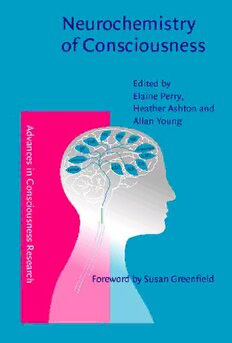
Neurochemistry of Consciousness. Neurotransmitters in Mind PDF
Preview Neurochemistry of Consciousness. Neurotransmitters in Mind
NeurochemistryofConsciousness Advances in Consciousness Research Advances in Consciousness Research provides a forum for scholars from differentscientificdisciplinesandfieldsofknowledgewhostudyconsciousness initsmultifacetedaspects.ThustheSerieswillinclude(butnotbelimitedto) thevariousareasofcognitivescience,includingcognitivepsychology,linguis- tics, brain science and philosophy. The orientation of the Series is toward developingnewinterdisciplinaryandintegrativeapproachesfortheinvestiga- tion, description and theory of consciousness, as well as the practical conse- quencesofthisresearchfortheindividualandsociety. SeriesA:TheoryandMethod.Contributionstothedevelopmentoftheoryand methodinthestudyofconsciousness. Editor MaximI.Stamenov BulgarianAcademyofSciences EditorialBoard DavidChalmers,UniversityofArizona GordonG.Globus,UniversityofCaliforniaatIrvine RayJackendoff,BrandeisUniversity ChristofKoch,CaliforniaInstituteofTechnology StephenKosslyn,HarvardUniversity EarlMacCormac,DukeUniversity GeorgeMandler,UniversityofCaliforniaatSanDiego JohnR.Searle,UniversityofCaliforniaatBerkeley PetraStoerig,UniversitätDüsseldorf FranciscoVarela,C.R.E.A.,EcolePolytechnique,Paris Volume36 NeurochemistryofConsciousness:Neurotransmittersinmind EditedbyElainePerry,HeatherAshtonandAllanYoung Neurochemistry of Consciousness Neurotransmitters in mind WithaForewordbySusanGreenfield Edited by Elaine Perry Heather Ashton Allan Young UniversityofNewcastle Newcastle-upon-Tyne JohnBenjaminsPublishingCompany Amsterdam(cid:1)/(cid:1)Philadelphia TM ThepaperusedinthispublicationmeetstheminimumrequirementsofAmerican 8 NationalStandardforInformationSciences–PermanenceofPaperforPrinted LibraryMaterials,ansiz39.48-1984. LibraryofCongressCataloging-in-PublicationData Neurochemistryofconsciousness.Neurotransmittersinmind.WithaforewordbySusan Greenfield/editedbyElainePerry,HeatherAshton,andAllanYoung. p. cm.(AdvancesinConsciousnessResearch,issn1381–589X;v.36) Includesbibliographicalreferencesandindex. 1. Consciousness. 2. Neurotransmitters. 3. Neurochemistry. 4. Neurobehavioral disorders.I.Perry,E.K.(ElaineK.)II.Ashton,Heather.III.Young,Allan,1983-IV.Series. QP411.N485 2002 153--dc21 2001052834 isbn902725156(cid:2)8(Eur.)/158811124(cid:2)5(US)(pbk.) ©2002–JohnBenjaminsB.V. Nopartofthisbookmaybereproducedinanyform,byprint,photoprint,microfilm,orany othermeans,withoutwrittenpermissionfromthepublisher. JohnBenjaminsPublishingCo.·P.O.Box36224·1020meAmsterdam·TheNetherlands JohnBenjaminsNorthAmerica·P.O.Box27519·Philadelphiapa19118-0519·usa Table of contents Foreword SusanGreenfield Preface I. NeurotransmitterSystems . Neurotransmitternetworks ElainePerryandAllanYoung . Cholinergictransmission:Novelsignaltransduction NancyJ.Woolf II. NaturalAlterationsofConsciousness . Attention AndrewScholey . Memory CarolineStewart . Motivation:Rewardandpunishmentsystems HeatherAshton . Sleep:Slowwaveandnon-REMstages AnnL.Sharpley . Dreaming:Cholinergicanddopaminergichypotheses MarkSolms . Dreaming:Monoaminergicdisinhibitionhypothesis ClaudeGottesmann Tableofcontents III. Drug-InducedAlterationsinConsciousness . Generalanesthetics PamelaFlood . Effectsofdrugsonsleep HeatherAshton . Neuroleptics CliveBallardandMargaretPiggott . Deliriumandhallucinations HeatherAshton . Plantsofthegods:Ethnicroutestoalteredconsciousness ElaineK.Perry IV. BrainPathologyandConsciousness . Alzheimer’sdisease:Focusonthecholinergicsystem DanielI.Kaufer . Parkinson’sdisease DagAarslandandRandiStarrfelt . DementiawithLewybodies:Adisorderofconsciousness? MatthewWalkerandElainePerry . Schizophrenia GavinP.Reynolds . Mooddisorders R.HamishMcAllister-Williams . Mentalretardationandautism GregoryO’BrienandLouiseBarnard Envoi Index Foreword SusanGreenfield The biggestquestion,arguably,thatanyscientistor indeedhuman beingcan ask, is how the mass of tissue in the brain can generate the inner experi- ence that we call consciousness: the state that no one else can access. How- ever articulate, poetic, musical or close to someone you may be, that elusive subjectivity,—the directfirst-hand‘feel’of the sunon yourface,orthe grass between bare toes,—is quintessentially personal, utterly subjective. This si- multaneouslyelusive,yetintimatephenomenonhas,ofcourse,keptdrovesof philosophers occupied throughout the ages. But it is only in the last ten or twentyyears,thatsciencehasactuallymovedin. Sincescientistsaretrainedtobeutterlyobjective,—wedon’tevenusethe activevoice,butpreferthefarmoreclumsy,passive;‘asolutionwasmadeup’ for example—it is small wonder that it goes against the grain now to bring the machineryofscientificmethodtobearagainstsuch anintractabletarget. Hencemanyscientists,includingandparticularlybrainscientists,tendtodis- tancethemselvesfromthisareaofstudy,onthegroundsthatitisimpossible, given current technologies and state of knowledge, to make any progress. As oneparticularcolleagueofmine,anexpertonAlzheimer’sDisease,remarked, “Ijusttakeconsciousnessforgranted”.Ontheotherhand,ifwearetoworkon thebrain,thensurelysuchanapproachisindefensible:asthephilosopherJohn Searle remarked, for brain scientists to ignore consciousness is like someone workingonthestomachtosaytheyarenotinterestedindigestion. Other scientists, nonetheless,fascinated by consciousness, simply cannot raise the funds for empirical investigation. Given the mystic-like image the word still conjures up to the mind-set of grant review panels, approaches have been sardonically dubbed ‘a career limiting move’. But despite this hostile culture there is, to their credit, a third, growing band of scientists who, nonetheless,are squaring up to the problem.Curiously, however,brain scientists have been conspicuously absent, in the early days, from this group ofpioneers.Forexamplethemathematician,RogerPenrose,andthephysicist, SusanGreenfield Brian Josephson,havemade importantcontributionstothe field.Evenwhen bio-medicalscientistsdotakethecentre-stage,asinthecaseofFrancisCrick, or Gerry Edelman, an immunologist, they are not necessarily known from their grounding in the basic brain sciences. An interesting feature, however, oftheindividualsmentioned,isthatthereisahighproportionofNobelPrize Winners! Untilnow,itseems,onlythosewhoalreadyhaveastrongscientificreputa- tionand,perhaps,thetimetoreflectontheseissuesawayfromthehurly-burly of peer-review papers and grant writing are able to contemplate this biggest, and most exciting question.However,the landscape is rapidly changing, and nowanincreasingnumberofneuroscientistsareexploringwhatcontributions theycanactuallymake. We are now looking beyond the stumbling block of causality: the water of neuronalsignalling, translatedinto the wine of subjective experience.The philosopherDavidChalmershasreferredtothisimpasseasthe‘HardProblem’. Where neurosciencenow might make a contribution,albeit a lessglamorous one than coming up with a simple rubric for the conversion, is in showing increasingly sensitive and precise correlations of consciousness, i.e. matching uphowpeoplefeelwithwhatisoccurringinthebrain. Giventhismorerealisticgoal,itissurprisinghowthefieldhaspreviously been dominated by mathematical models of networks of neurons. We know that such neuronal networks are quasi-permanent, slow to form, and highly localwithinthebrain.Althoughtheymaybeabasisforlearningandmemory, weknowthatyoucanbeconsciouswithoutlearningorrememberinganything and,similarly,thatcomputerprocessescanoccurthatwillmodifyresponsesto subsequentstimulus,butatthesametimedonotentailaconsciousexperience. Ifwearetolookforacorrelationofconsciousness,thendrugsofferaperfect RosettaStone,—afterall,bymanipulatingthechemicalsinourbrainwithcer- taindrugs,wecan,ontheonehand,reportchangesinhowwefeelbut,atthe sametime,matchthisupwiththechemistryofthebrain.Moreover,giventhat psychoactivedrugsmodifyouremotions,anddosobymodifyingchemicalsin thebrain,itfollowsthatemotionshaveachemicalbasis.Nowweconsiderthat although learningandmemory can be dissociated fromconsciousness,emo- tions cannot (we are always feeling something, howeverlow level). It follows that clearly chemicals, forming the basis as they do of brain function, must alsoformthebuildingblocksofconsciousness. Howstrangethen,thatupuntilnow,thesilentsectorofthebrainresearch communityhasbeentheneurochemistsandtheneuropharmacologists. Foreword Thisbook isnowsettobuckthe trend.Starting with ageneralintroduc- tion to brain chemistry, the reader can take a journey through normal brain processes,intotheworldofdrug-inducedchangesinconsciousness,andfinally intothe chilling worldofdysfunctionsin consciousness.Subjects coveredare trulycomprehensiveandofsuchanastonishingrange,thateventhededicated brain specialist will be able to learn something, as well as the non-specialist, andgainawonderfuloverviewofhowconsciousnessmighttakeplacewithin the brain. The Hard Problem, of course, remains unsolved. But it is only by a trulyscientific approach, such as found in these pages, that by building on whatweknow,wewillbeabletomakeanyprogressatall.
